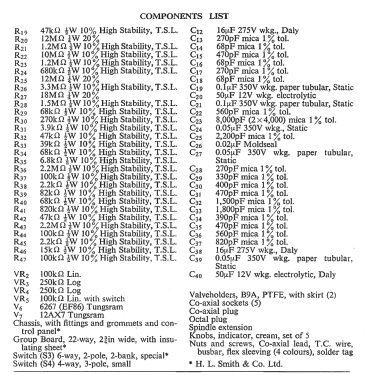Control Unit Mk. II (2)
Cooper-Smith (Brand), H.L. Smith & Co. Ltd.; London
- Pays
- Royaume Uni
- Fabricant / Marque
- Cooper-Smith (Brand), H.L. Smith & Co. Ltd.; London
- Année
- 1958
- Catégorie
- Amplificateur BF ou mélangeur BF
- Radiomuseum.org ID
- 339339
Cliquez sur la vignette du schéma pour le demander en tant que document gratuit.
- No. de tubes
- 2
- Principe général
- Amplification audio
- Gammes d'ondes
- - sans
- Tension / type courant
- Alimentation Courant Alternatif (CA) / 200, 220 & 240 Volt
- Haut-parleur
- - Ce modèle nécessite des HP externes
- Matière
- Boitier métallique, lampes visibles
- De Radiomuseum.org
- Modèle: Control Unit Mk. II - Cooper-Smith Brand, H.L. Smith
- Forme
- Chassis (pour intégration dans meuble)
- Dimensions (LHP)
- 9.25 x 2.25 x 5.75 inch / 235 x 57 x 146 mm
- Remarques
-
The Control Unit Mk. II employs a low noise, high gain pentode (6267) with negative feedback from the anode to the grid. On the three pick·up switch positions, the feedback becomes frequency selective. providing the appropriate equalisation for the playback of disc recordings. As most modem L.P. recordings are made with a standardised RIAA. characteristic, it was decided that only one main L.P. equalisation network was necessary, and any departure from the correct curve could be compensated for by judicious use of the wide range tone controls.
However, provision has been made for the playing of older L.P. recordings which were recorded at a somewhat lower level and require bass correction at a slightly higher frequency.
The 78 r.p.m. equalisation is based on the EMI curve, and with the use of tone controls and filter this should cater for all types of recording characteristics.The pick-up input will accommodate practically any type of pick-up, including crystals that have been loaded to give an output proportional to stylus velocity, which means that the crystal pick-up behaves very much like a magnetic. The Collaro transcription pick-up will feed straight in, as the input volume control is of the correct value (100 kΩ) and is all that is necessary for the constant velocity conversion.
Approximately 15dB of bass and treble lift and cut are provided at settings on either side of the central positions.
The input sensitivities on the remaining switch positions are controlled by fixed amounts of feedback,
Stage 2
This is essentially a voltage amplifier and performs no function other than to make up for the loss of gain due to the tone control circuit. The output of this stage is fed into the low-pass filter. By the use of resistance capacity networks and negative feedback, the latter provides an attenuation of better than 12 dB per octave of frequencies above 10 kc/s, 8 kc/s, and 6 kc/s respectively, these being selected by S4. The filter is not usually necessary on LP records but it can prove invaluable in suppressing unwanted noise such as heterodyne whistles on AM signals or surface noise on shellac records.
A rumble filter is also incorporated into the circuit to attenuate frequencies below 35 c/s, thereby preventing sub-audio frequencies from overloading the system. These latter frequencies are produced in the main by mechanical noises in cheap or faulty gramophone motors, especially when the listener favors accentuated bass in their reproduction,Stage 3
This provides negative feedback for the filter and the main amplifier. The volume control is connected to the output end of the stage so that internal noises such as hum, valve hiss, etc., are reduced in direct relation to the signal.
Technical Details
Inputs: Radio, Gramophone, Microphone, Equalised Tape
Filter: approx. 12 dB per octave cut at 10 KC/S, 8 kc/s, and 6 kc/s
Tone Controls: Bass and Treble lift and cut
Input Sensitivities:
Radio and Tape: 100 mV
Gramophone: 3 mV
Microphone: 1.5 mV
Output: 1.75 V
Input Impedance: 100,000 ΩSwitch Positions:
- Radio
- LP
- 78
- Early LP
- Mic
- Tape
- Schémathèque (1)
- -- Original prospect or advert (Radio Constructor Feb 1958, page 480)
- Auteur
- Modèle crée par Gary Cowans. Voir les propositions de modification pour les contributeurs supplémentaires.
- D'autres Modèles
-
Vous pourrez trouver sous ce lien 6 modèles d'appareils, 4 avec des images et 5 avec des schémas.
Tous les appareils de Cooper-Smith (Brand), H.L. Smith & Co. Ltd.; London

